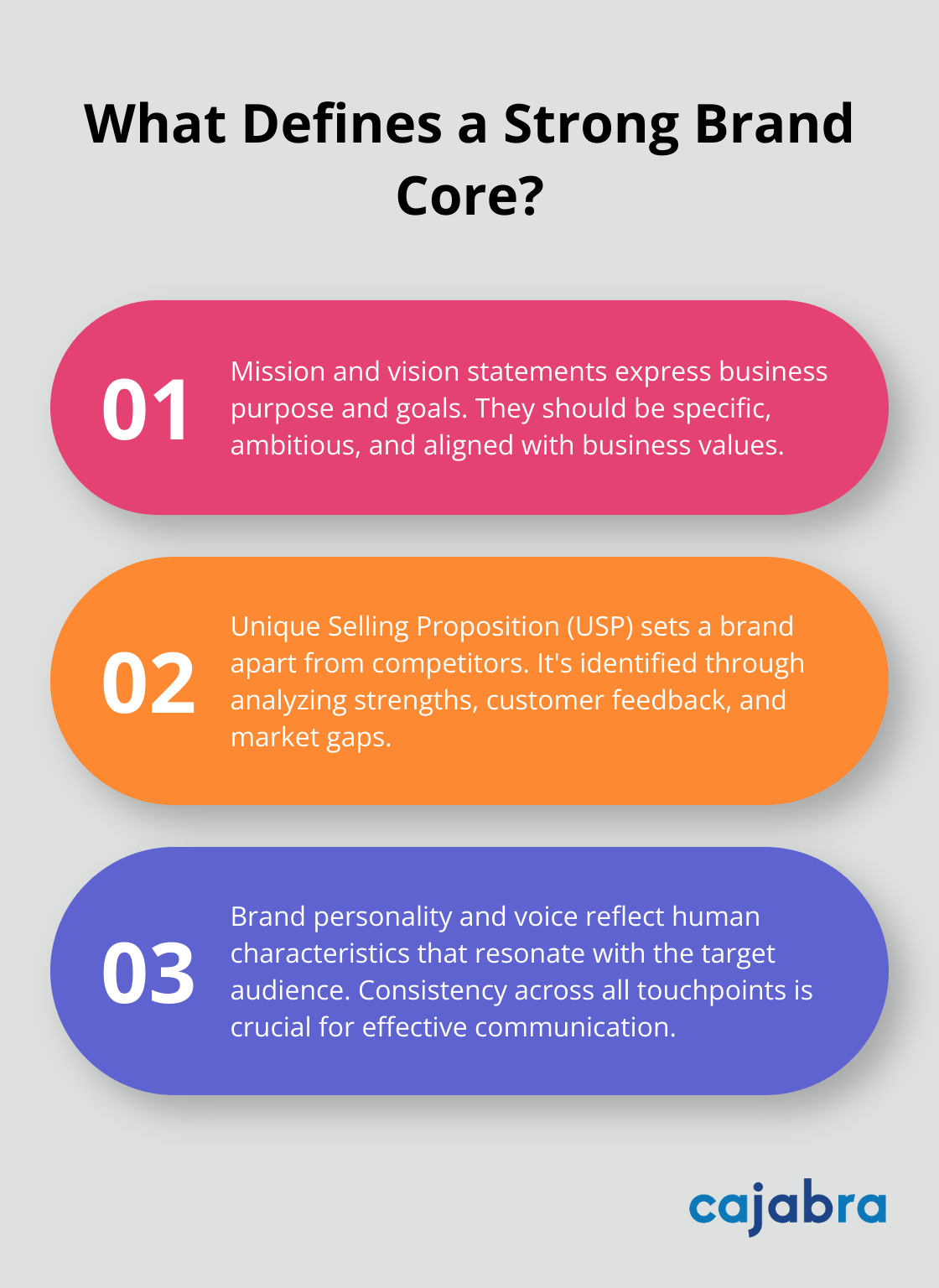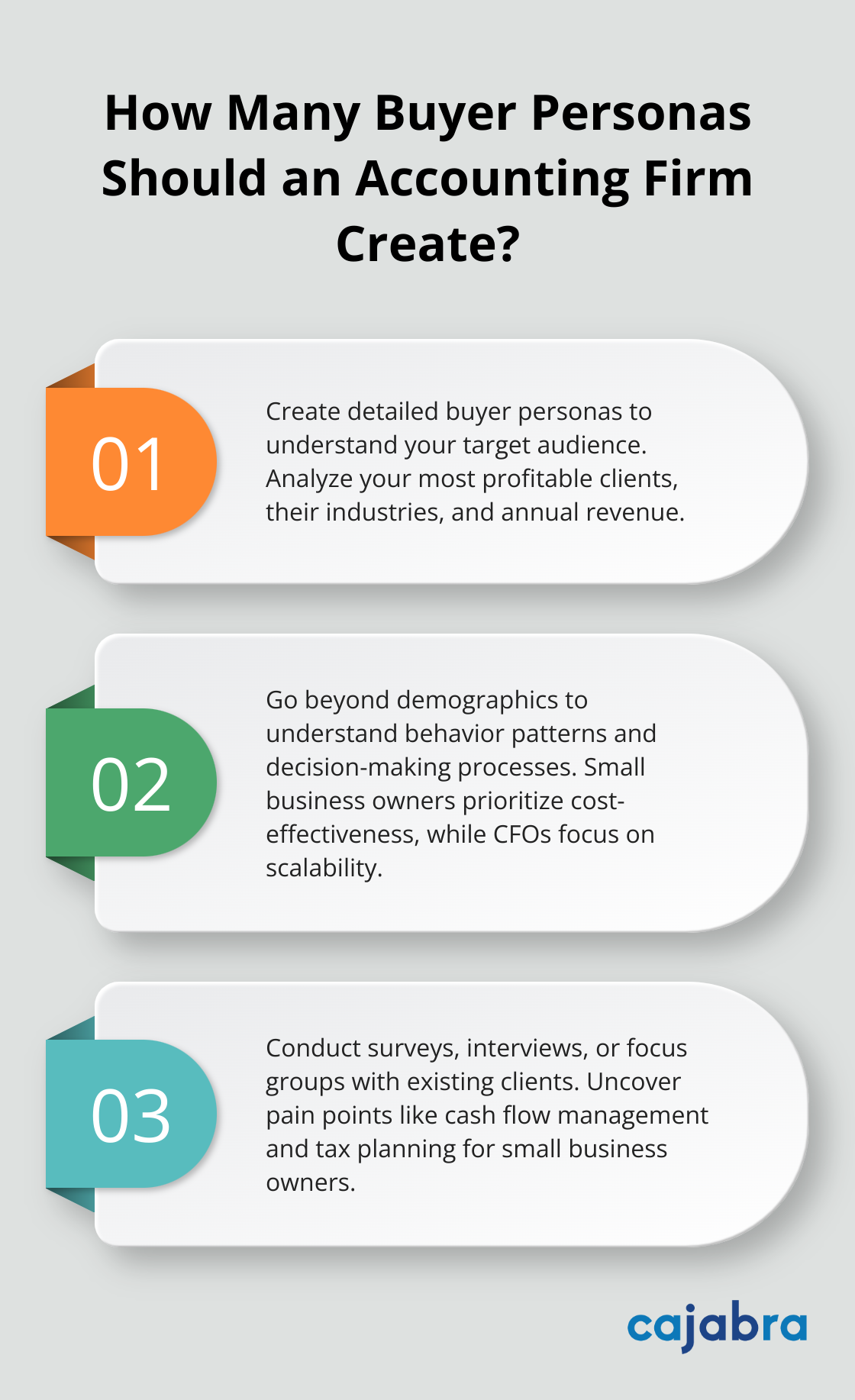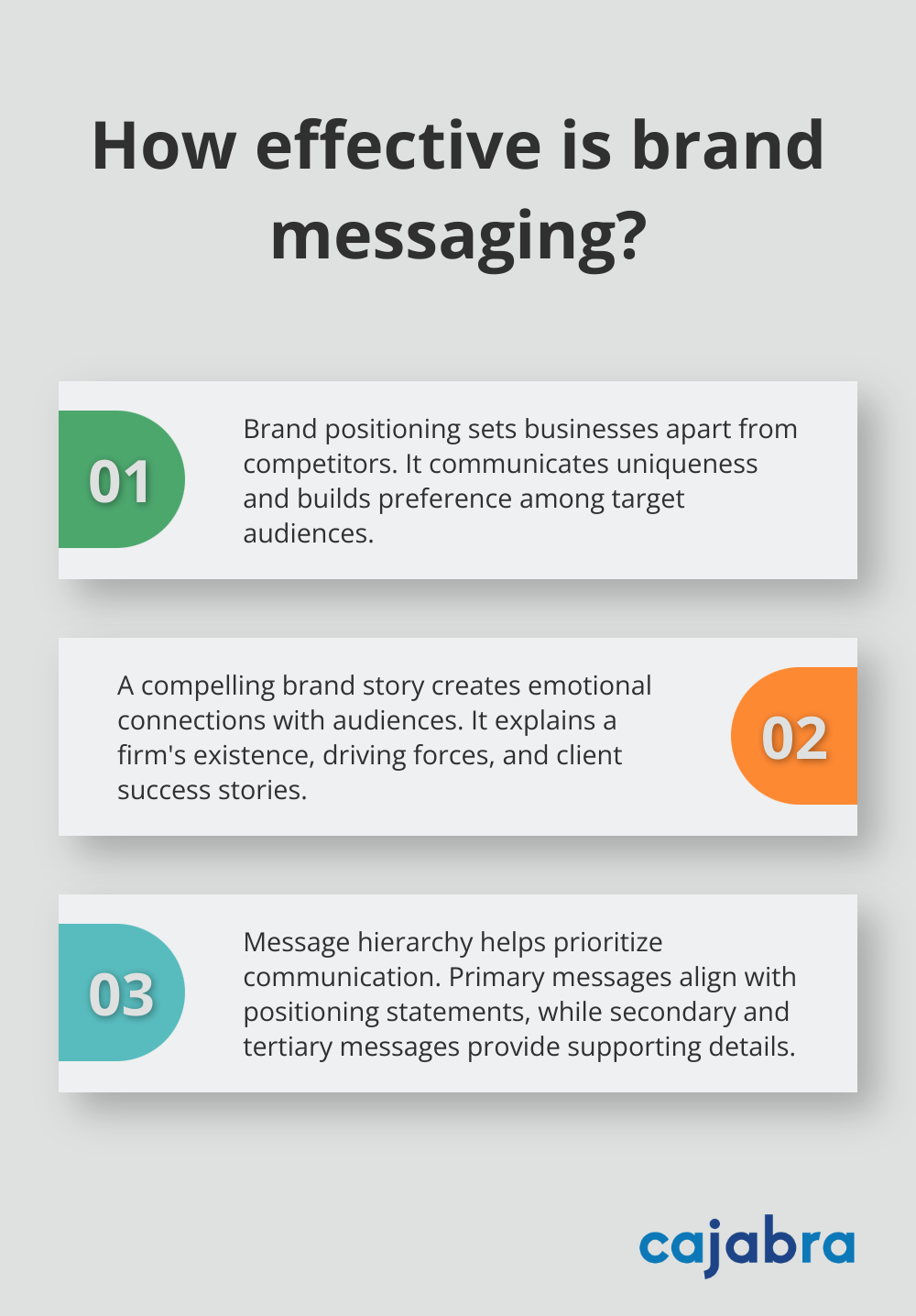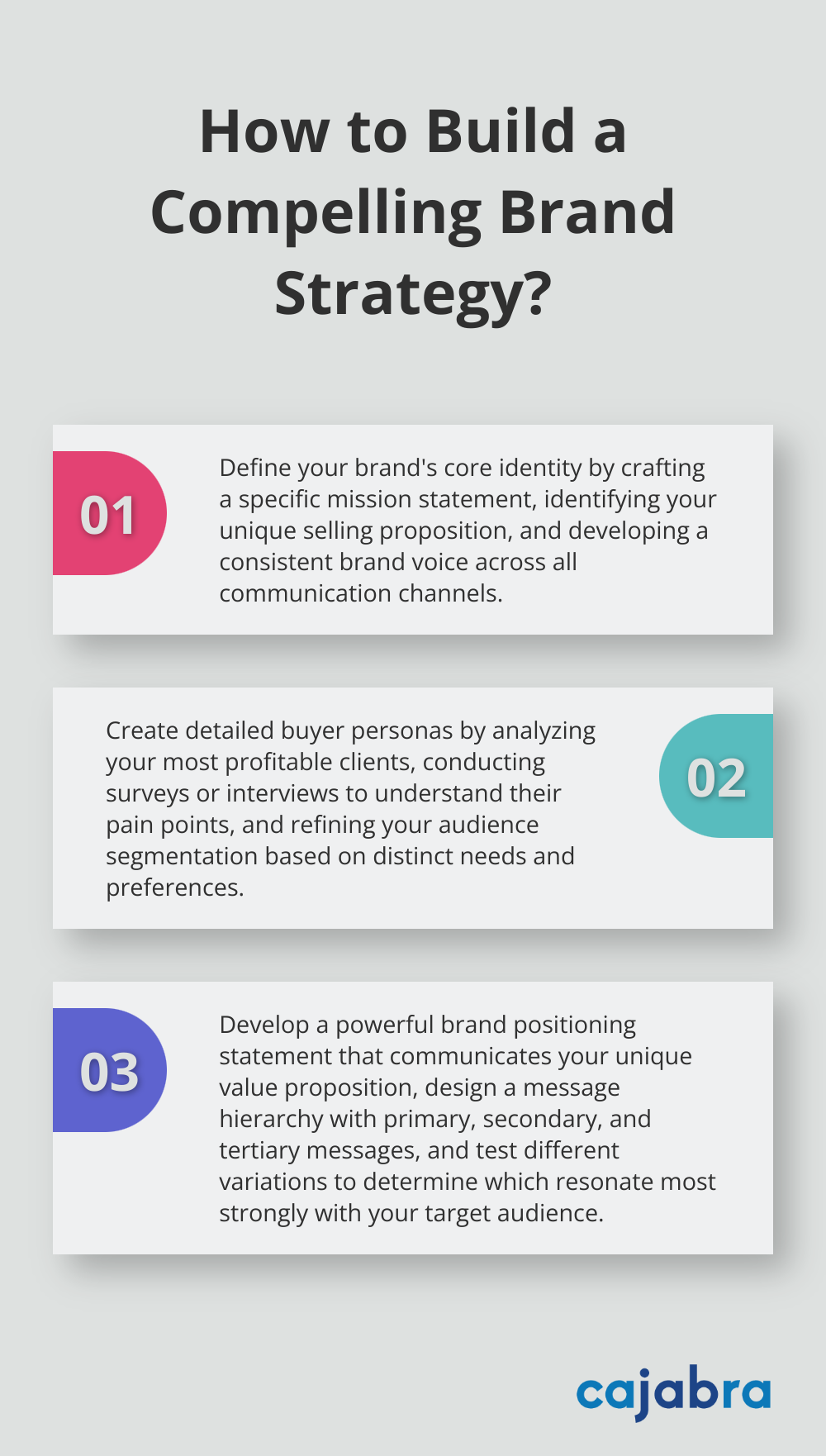
At Cajabra, LLC, we know that a strong brand messaging strategy is the backbone of effective marketing.
Our brand messaging strategy template will guide you through the process of defining your brand's identity, understanding your audience, and crafting compelling messages.
This step-by-step approach will help you create a consistent and powerful brand voice across all your communication channels.
A strong brand's core identity forms the foundation of an effective messaging strategy. This chapter explores how to establish a powerful brand core that resonates with your target audience.
Your mission statement should concisely express your business's purpose and goals. It answers the question: "Why does your business exist?" Your vision paints a picture of your desired future state. When you create these statements, be specific and ambitious, but ensure they align with your business goals and values.
Your Unique Selling Proposition (USP) sets you apart from competitors. To identify your USP, analyze your strengths, customer feedback, and market gaps. Ask yourself: "What do we do better than anyone else?" and "What unique value do we provide to our clients?" For accounting firms, this could be specialized expertise, innovative technology use, or exceptional client service.
Your brand personality should reflect the human characteristics that resonate with your target audience. Are you professional and authoritative? Friendly and approachable? Innovative and forward-thinking? Your brand voice is how this personality comes across in your communications.

For example, if you target small businesses, a warm and supportive tone might work well. If you aim for large corporations, a more formal and expert tone could prove more effective. Consistency is key here - your brand's core identity should reflect across all touchpoints (from your website and social media to client interactions and marketing materials).
Your core values guide your company's behavior and decision-making processes. They should align with your business goals and resonate with your target audience. For instance, if you value innovation, this should reflect in your services and how you communicate with clients.
A compelling brand story can help you connect with your audience on an emotional level. It should include your company's history, challenges you've overcome, and your vision for the future. This narrative can help potential clients understand your journey and relate to your brand on a deeper level.
As you define these elements of your brand's core identity, you'll build a solid foundation for all your marketing efforts. This clarity will guide your messaging, help you attract ideal clients, and ultimately drive your business growth. The next step is to understand your target audience deeply, which we'll explore in the following chapter.
Understanding your target audience is essential for an effective brand messaging strategy. Creating detailed buyer personas paints a vivid picture of your ideal client. When creating and using a buyer persona, the intention is to take the generalized focus of your target market and narrow it down even more. Start by analyzing your current client base. Identify your most profitable clients, their industries, and annual revenue.

Go beyond demographics. Understand their behavior patterns, challenges, and decision-making processes. A small business owner might prioritize cost-effectiveness and personal attention, while a CFO of a large corporation might focus on scalability and advanced reporting capabilities.
To resonate with your audience, you need to understand their struggles and aspirations. Conduct surveys, interviews, or focus groups with your existing clients. Ask open-ended questions about their biggest financial challenges, what keeps them up at night, and what they wish their accountant could do better.
Many small business owners struggle with cash flow management and tax planning. By addressing these specific pain points in your messaging, you'll immediately grab their attention and position your firm as a solution provider.
Analyzing your competitors isn't about copying them-it's about finding gaps and opportunities. Competitive analysis means identifying your competitors and evaluating their strategies to determine their strengths and weaknesses relative to your own. Visit their websites, social media profiles, and marketing materials. What tone do they use? What services do they emphasize? What unique selling propositions do they highlight?
Look for areas where your competitors fall short. Perhaps they all focus on traditional services, leaving an opportunity for you to highlight your expertise in emerging areas (like cryptocurrency accounting or AI-powered financial forecasting).
Your goal isn't to be better than your competitors at everything. It's about finding your unique angle. While other firms might compete on price, you could focus on your specialized industry knowledge or your tech-forward approach.
Use market research tools and techniques to gather data about your target audience. This can include surveys, focus groups, and analysis of industry trends. Try to identify patterns in client behavior, preferences, and needs.
For example, you might discover that a significant portion of your target market struggles with understanding complex financial reports. This insight could lead you to develop simplified reporting tools or educational resources, setting you apart from competitors.
As you gather more information about your target audience, you might find that you have multiple distinct segments. Each of these segments may have different needs, preferences, and pain points.
Refine your audience segmentation based on these insights. You might create separate personas for small business owners, non-profit organizations, and large corporations. This detailed segmentation will allow you to tailor your messaging more effectively to each group.
With a thorough understanding of your audience and competitive landscape, you're now ready to craft messages that truly resonate. In the next chapter, we'll explore how to use these insights to create compelling brand messages that speak directly to your ideal clients' needs and desires.
Your brand positioning sets your business apart from your competitors and builds preference among your target audience. It should communicate what sets your accounting firm apart from competitors. A well-crafted positioning statement typically includes your target audience, the problem you solve, and how you solve it uniquely.

For example, a positioning statement for an accounting firm might be: "For small businesses seeking financial clarity and growth, [Your Firm Name] provides personalized accounting solutions powered by cutting-edge technology, enabling owners to make confident decisions and focus on their core business."
To create your positioning statement, list your firm's key strengths and unique offerings. Then, match these with the primary needs and pain points of your target audience. Try to find the sweet spot where your strengths align perfectly with your clients' needs.
A compelling brand story can create an emotional connection with your audience. Your story should explain why your firm exists, what drives you, and how you've helped clients overcome challenges. This narrative helps potential clients see themselves in your story and understand how you can help them.
When you craft your brand story, consider including:
Keep your brand story authentic and aligned with your firm's values. Authenticity builds trust, which is essential in the accounting industry.
Not all messages hold equal importance. Some should receive more emphasis than others. A message hierarchy helps companies communicate their values and goals to customers in a clear and concise way.
Start by identifying your primary message - the one thing you want every potential client to know about your firm. This should align closely with your positioning statement. Then, develop secondary and tertiary messages that support and expand on your primary message.
For example:
Primary Message: We provide tech-driven accounting solutions that give small businesses financial clarity and confidence.
Secondary Messages:
Tertiary Messages:
Tailor these messages for different channels. Your website homepage might focus on your primary and secondary messages, while social media posts could highlight tertiary messages or expand on specific aspects of your secondary messages.
Once you've crafted your brand messages, test them with your target audience. Use A/B testing on your website, run small-scale ad campaigns with different messaging, or conduct focus groups with potential clients.
Pay attention to which messages resonate most strongly. Do they prompt action? Do they generate questions or engagement? Use these insights to refine your messaging continually.
Effective brand messaging is not a one-time task. As your firm grows, your services evolve, and market conditions change, your messaging strategy should adapt accordingly. Regular reviews and updates of your messaging strategy will ensure it remains relevant and effective.
A well-crafted brand messaging strategy template forms the cornerstone of effective marketing for accounting firms. This template provides a roadmap for success, guiding you through each step of the process to create a powerful framework that sets your firm apart. Consistency proves key when you implement your brand messaging strategy across all touchpoints, building trust and reinforcing your brand identity.

Your brand messaging strategy must adapt to the constantly evolving business landscape. Regular feedback gathering, market monitoring, and message refinement ensure your brand remains relevant and impactful. This ongoing process keeps your brand fresh and aligned with your clients' needs, maintaining your competitive edge.
At Cajabra, we understand the unique challenges accounting firms face in developing effective brand messaging strategies. Our specialized marketing services for accountants help you create a powerful brand identity, craft compelling messages, and attract retainer-based clients (allowing you to focus on serving your clients and growing your firm).



